Intel's Ivy Bridge Architecture Exposed
by Anand Lal Shimpi on September 17, 2011 2:00 AM EST- Posted in
- CPUs
- Intel
- Ivy Bridge
- IDF 2011
- Trade Shows
The New GPU
Westmere marked a change in the way Intel approached integrated graphics. The GPU was moved onto the CPU package and used an n-1 manufacturing process (45nm when the CPU was 32nm). Performance improved but it still wasn't exactly what we'd call acceptable.
Sandy Bridge brought a completely redesigned GPU core onto the processor die itself. As a co-resident of the CPU, the GPU was treated as somewhat of an equal - both processors were built on the same 32nm process.
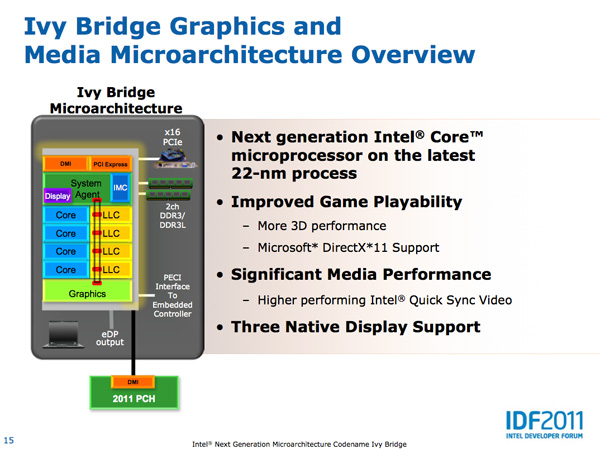
With Ivy Bridge the GPU remains on die but it grows more than the CPU does this generation. Intel isn't disclosing the die split but there are more execution units this round (16 up from 12 in SNB) so it would appear as if the GPU occupies a greater percentage of the die than it did last generation. It's not near a 50/50 split yet, but it's continued indication that Intel is taking GPU performance seriously.
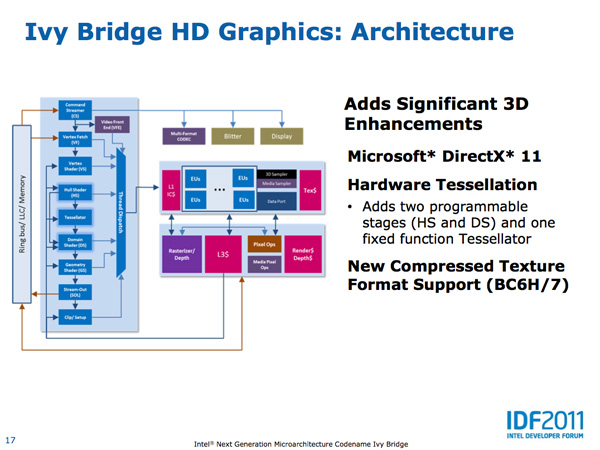
The Ivy Bridge GPU adds support for OpenCL 1.1, DirectX 11 and OpenGL 3.1. This will finally bring Intel's GPU feature set on par with AMD's. Ivy also adds three display outputs (up from two in Sandy Bridge). Finally, Ivy Bridge improves anisotropic filtering quality. As Intel Fellow Tom Piazza put it, "we now draw circles instead of flower petals" referring to image output from the famous AF tester.
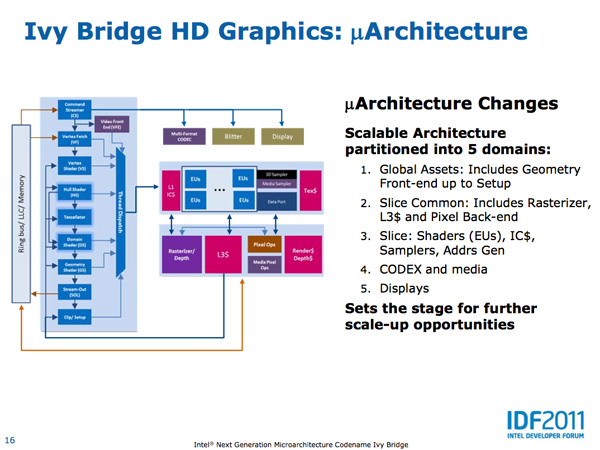
Intel made the Ivy Bridge GPU more modular than before. In SNB there were two GPU configurations: GT1 and GT2. Sandy Bridge's GT1 had 6 EUs (shaders/cores/execution units) while GT2 had 12 EUs, both configurations had one texture sampler. Ivy Bridge was designed to scale up and down more easily. GT2 has 16 EUs and 2 texture samplers, while GT1 has an unknown number of EUs (I'd assume 8) and 1 texture sampler.
I mentioned that Ivy Bridge was designed to scale up, unfortunately that upwards scaling won't be happening in IVB - GT2 will be the fastest configuration available. The implication is that Intel had plans for IVB with a beefier GPU but it didn't make the cut. Perhaps we will see that change in Haswell.
As we've already mentioned, Intel is increasing the number of EUs in Ivy Bridge however these EUs are much better performers than their predecessors. Sandy Bridge's EUs could co-issue MADs and transcendental operations, Ivy Bridge can do twice as many MADs per clock. As a result, a single Ivy Bridge EU gets close to twice the IPC of a Sandy Bridge EU - in other words, you're looking at nearly 2x the GFLOPS in shader bound operations as Sandy Bridge per EU. Combine that with more EUs in Ivy Bridge and this is where the bulk of the up-to-60% increase in GPU performance comes from.
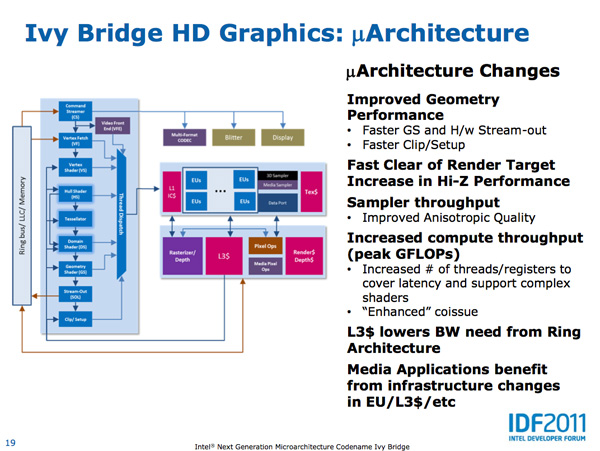
Intel also added a graphics-specific L3 cache within Ivy Bridge. Despite being able to share the CPU's L3 cache, a smaller cache located within the graphics core allows frequently accessed data to be accessed without firing up the ring bus.
There are other performance enhancements within the shader core. Scatter & gather operations now execute 32x faster than Sandy Bridge, which has implications for both GPU compute and general 3D gaming performance.
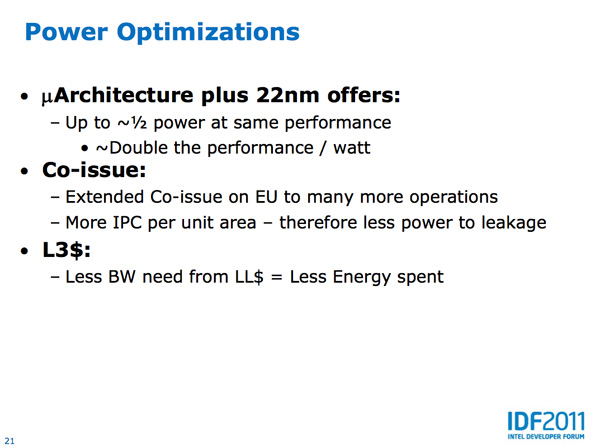
Despite the focus on performance, Intel actually reduced the GPU clock in Ivy Bridge. It now runs at up to 95% of the SNB GPU clock, at a lower voltage, while offering much higher performance. Thanks primarily to Intel's 22nm process (the aforementioned architectural improvements help as well), GPU performance per watt nearly doubles over Sandy Bridge. In our Llano review we found that AMD delivered much longer battery life in games (nearly 2x SNB) - Ivy Bridge should be able to help address this.
Quick Sync Performance Improved
With Sandy Bridge Intel introduced an extremely high performing hardware video transcode engine called Quick Sync. The solution ended up delivering the best combination of image quality and performance of any available hardware accelerated transcoding options from AMD, Intel and NVIDIA. Quick Sync leverages a combination of fixed function hardware, IVB's video decode engine and the EU array.
The increase in EUs and improvements to their throughput both contribute to increases in Quick Sync transcoding performance. Presumably Intel has also done some work on the decode side as well, which is actually one of the reasons Sandy Bridge was so fast at transcoding video. The combination of all of this results in up to 2x the video transcoding performance of Sandy Bridge. There's also the option of seeing less of a performance increase but delivering better image quality.
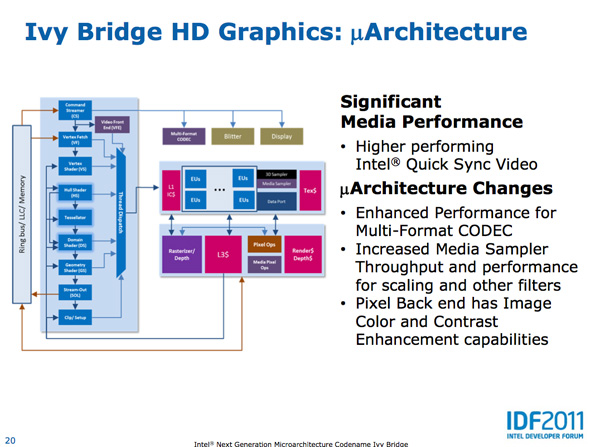
I've complained in the past about the lack of free transcoding applications (e.g. Handbrake, x264) that support Quick Sync. I suspect things will be better upon Ivy Bridge's arrival.
















97 Comments
View All Comments
piroroadkill - Saturday, September 17, 2011 - link
I'd have liked a little more on this.. What's the source?I searched anyway, and found it is using thermal sampling. Presumably it's also seeded. Anyway, I thought it was of interest.
Jamahl - Saturday, September 17, 2011 - link
Don't you get tired of saying "intel is finally taking gpu performance seriously" every year? I do.JonnyDough - Monday, September 19, 2011 - link
I'd just like to say...=) Yes sir, I do.
imaheadcase - Saturday, September 17, 2011 - link
I heard when sandy bridge came out they was considering a GPUless version for enthusiasts who don't need it..is that something they will do eventually?I suspect its tied to the core, so not going to happen because of high costs. But wouldn't that save even more power/heat problems with that removed?
It just seems like its a mobile orientated cpu vs consumer. :D
DanNeely - Saturday, September 17, 2011 - link
With power gating if you're not using the IGP it doesn't consume any power; so the only thing they'd save on is die area by removing it.imaheadcase - Saturday, September 17, 2011 - link
Ah did not know that part. thanks.fic2 - Monday, September 19, 2011 - link
"I heard when sandy bridge came out they was considering a GPUless version for enthusiasts who don't need it..."Interesting since Intel did the exact opposite - put the only GPU with half decent performance into the enthusiast 'K' series.
JonnyDough - Monday, September 19, 2011 - link
The only people who would actually consider that are businesses and home users who don't play "real" games. :Pjjj - Saturday, September 17, 2011 - link
"I believe that x86 CPU performance is what sells CPUs today"That's not all that true anymore,there was a time when apps used by everybody required a fast CPU but that's not the case anymore nowdays..Just a few years ago playing HD content was a chalange on older systems but now ,if you look at usage paterns and what kind of perf is needed, the picture has changed. This is one of the reasons PC sales are not doing so great,there is no need to upgrade your system every 1-2 years.Even Windows is not driving system requirements up anymore.
In the consumer space GPU and battery life matter more now. Intel is trying to fight all this with lower power consumption, ultrabooks but that far from enough.If they want to survive the ARM "tsunami" (think about the financial part too here not just perf) , they got to push the software to be more demanding too and maybe the easiest is to do it on the GPU side -not in games.
MadMan007 - Saturday, September 17, 2011 - link
Intel's quarterly results say there is less to worry about than hyperbolic ARM domination headlines would lead one to think. One IDF slide showed large growth in emerging markets where the analysts aren't as able to get reliable data. Yes, PC upgrade cycles are longer, but that doesn't mean there is not net worldwide growth.There is room for growth in both areas, it's not a zero-sum game, and some things like mobile video consumption actually go hand-in-hand with faster beefy CPUs.